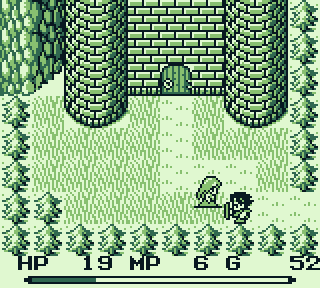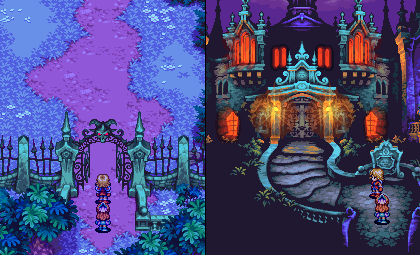There is one special game I have very fond memories of. It is Mystic
Quest on GameBoy. Don’t mix it up with Mystic Quest for the SNES, this is a very different game. Mystic Quest is the prequel to Secret of Mana for the SNES.
Mystic Quest was and still is one of the best GameBoy titles of all time. Recently, a remake was released for the GBA with the title Sword of Mana. Having such an amazing game as template, what could go wrong? It turns out, EVERYTHING went wrong. There is really nothing about Sword of Mana which could be considered at least as good as Mystic Quest. This is great because now we are able to compare those two games and to point out exactly what made Mystic Quest so great in the first place.
That’s no moon. It’s a dungeon.
First of all, let me get the complicated history straight. Mystic Quest is called Final Fantasy Adventure in the US and Seiken Densetsu: Final Fantasy Gaiden in Japan. So Mystic Quest is the prequel to Seiken Densetsu 2 which appeared for the SNES and was released as Secret of Mana in Europe and the US. I wonder, why do old JRPGs always have so incredibly complicated release histories?
In this article, I will focus on a very small detail which shows very nicely the difference between the game design philosophies of the two titles. Quite early in the game, the player has to escort a young lady through a dangerous forest. On his way, he stumbles upon a mansion. At first, it seems like a normal inn. However, as soon as the both main characters go to sleep, the young lady gets kidnapped and thus, a new adventure begins.
Let us compare the visual representation of the said mansion. In Mystic Quest, the mansion looks like a quite normal, small castle. It is made up of standard castle tiles which are used for every castle in the game. There is nothing special about it.
An elegant castle from a more civilized age.
In Sword of Mana, the player enters through a gate decorated with a horned skull with glowing eyes. He is only able to enter at night. The mansion itself ls a custom graphic specially done for the mansion and it looks especially dark end menacing. There is even a cut-scene where the main characters discuss how suspicious and scary the place seems. Even some other mysterious character appears and tells that there is a vampire living inside who kidnaps young ladies.
You will never find a more wretched hive of scum and villainy. We must be cautious.
As a result, in Mystic Quest the abduction is quite the surprise for the player. It binds the player emotionally because the loss of the supporting character is unforeseen and sudden. The player even might blame himself for loosing his companion because he wasn’t able to recognize the trap.
In Sword of Mana, because of the massive amount of foreshadowing, it is completely obvious that something bad will happen. The player will expect the abduction. Also, it is apparent that the abduction is part of the elaborate story of the game as there are even cut-scenes which introduce the mansion. The emotional impact is weak.
It seems counter-intuitive but actually, LESS emphasis on some parts of the story create MORE emotional response. This is something which goes well with Rowan Kaiser’s recent article in The Escapist. He suggests applying the admonition “Show, don’t tell”. I would go even further and change it into “Do, don’t show” to avoid any misunderstandings. The problem is, as always, that games aren’t movies.
Nooo! Look behind you! Turn around! .. Gaaah! Give me that controller, you incompetent idiot!
When we watch a thriller, and we see Janet Leigh take a shower and the killer waiting outside it creates suspense because we foresee what will happen but we have no means to change the course of events. We are doomed to watch the murder happen and thus can do nothing but feel sorry for the victim.
Games are different. In games we CAN do something. The player IS Janet Leigh and the only way she would make the decision to take that shower is if she didn’t knew that there is a killer outside. In games the emotional connection does not happen through emphaty but through responsibility. As soon a the player realizes a decision was made by somebody else in advance, he disconnects emotionally: “Oh, ok, it is is not my fault, it was meant to happen”.
So the same techniques used to evoke emotional response in films actually destroy it in games. Instead foreshadowing events, games should remain neutral and ambiguous to what might happen next. This way even scripted events will appear as just one of many possible ways the story could unfold.
Finally, when I talked about it with Daniel Renkel, he suggested that the game designer of Mystic Quest made the mansion so low-profile only because budget and technology wouldn’t allow otherwise. It seems that he might be right. Mystic Quest and Sword of Mana were both directed and designed by the same person, Koichi Ishii. It looks like George Lucas in no longer alone.






nice analogy to Lucas
I don’t know if it’s a matter of course, but for me, the same goes for gameplay.
Even for tutorial tasks, I find it far better not to spell out every step.
Example: show the treasure chest up the hill, show the jump button, but don’t talk about the ledges and the gaps which have to be overcome.
Show the goal (”high level”) and show the basic controls (”low level”), but let the player fill in the “blank”, even if it’s completely obvious.
Tutorials – Nice analogy. In the same way players disconnect from the story when they realize the decisions were made before by somebody else, players tend to expect the kind of help they get in tutorials, stop thinking and as a result get stuck more often. Less is more.
Clint Hocking recently gave an Interview for Gamasutra with similar observations:
http://www.gamasutra.com/features/20070514/ruberg_01.shtml
“For me, learning what it means to not be an author, learning what it means to give up control, learning to say, “Okay, it’s not my job to make decisions about meaning for the player, it’s just to give the player the space around that decision,” it’s a hard thing to let go of. It’s so attractive and sexy. It’s what all of our great authors throughout history have always done. But people in our medium, designers, it’s not what we’re supposed to do, I don’t think. [...] We just need to lead the reader to make his own decisions. Very few readers will read Macbeth will say Lady Macbeth was a good person. It’s clear that you’re supposed to think that she’s a bad person.”
Thanks for the thought-provoking article, but I have to disagree with the general gist of what you’re saying. You’re talking about the difference between a surprise approach and a suspense approach. To take your example of Hitchcock, he happened to favour suspense, but there must be plenty of examples of both approaches that work perfectly well in both games and film. I suspect the example you point to of the spooky-lookin’ mansion fails simply because it’s ham-fisted, not because it’s within an interactive medium.
If you can imagine Hitchcock’s famous example of suspense working in a game then you have to say that suspense still counts in games. It goes something like this…
–There’s a couple talking in a cafe. In a bag under their table there ticks a bomb. Now is it better to show the bomb at the beginning of the scene, ticking away, tension building, or only at the end when it explodes?–
Now I always found Hitchcockian suspense a bit manipulative and crude – but he’s got a point, no?
@darri: good comment. Let me try to answer it.
I think the example you’ve mentioned with the couple clearly doesn’t work well in an interactive medium. What you described is a setting and a story as it would appear in a movie. That works fine but when you are talking about an interactive medium you also have to define what role the player takes in this scenario and how can he interact with it. So is the player the couple? Or is he a terrorist who put the bomb there? Or is he the manager of the restaurant or what? I think for a proper example you should define those points too.
In any case, showing the player the bomb “at the beginning” would prompt him to use his abilities to try to affect the foreshadowed event (diffuse, escape ect.) in some way.
This is exactly what doesn’t happen in a Movie. In a Hitchcock story the audience is in a passive situation and has no possibility to follow the urge to do something about the bomb. To strengthen the effect the characters would be oblivious to the bomb and do something completly against that urge by sitting and talking about waffles. By “supressing” that urge and teasing the audience, suspense is created.
As you can see, in an interactive environment the same setup leads to a very different experience. We are comparing apples to oranges.
The problem is that in most cases, “The Story” of a game is an embedded element and one of the things the player can’t change in any profound way. So in the case of the Bomb, the player’s abilities would be set up in such a way that he wouldn’t be able to stop the bomb or change its effect on the course of the story. The bomb is a part “outside” of the game. A cutscene, something the player is not responsible for. Then, the time between the first picture of the bomb and the explosion is wasted time for the player, just another something he has to sit trough until he can act again.
to me, there is nothing in a game quite as satisfying as not knowing what’s about to happen next.
really, it might just be the nostalgia talking, but what was more beautiful that getting dropped into the Legend of Zelda without any instruction or backstory, and being unleashed into the mysterious world.
i think storylines in general destroy games, because as you stated, THEY ARE NOT MOVIES.
im in school for game design right now and we spent a few lectures going over character development, which was very frustrating.
I do not care about my character’s past, and I don’t care about any extra plot other than what I can deduce (or even better, imagine) from the gameplay.
Unless of course it is absurdly original (ex. Earthbound)
But i think it is quite a rare artform in itself to actually have story enhance the game.
i dig your blog, very interesting things ,video game analysis is the concrete of modern enthropology.perhaps?
Thanks, I would rather consider design in general as a form of applied Anthropology.
"So Mystic Quest is the sequel to Seiken Densetsu 2 which appeared for the SNES and was released as Secret of Mana in Europe and the US."
Surely you mean "PREquel", right…?
You are right! Thank you! See, I'm getting confused myself. ^_^'
Heh, I have been against the blatant overuse of cutscenes for a long time, but I was never able to word it so well as you did. Especially in regards to why movies and games are different and are, for the most part, incompatible.
I will take this (and the interface review regarding Mass Effect) to heart while designing my oewn game. It should come out better because of it
[...] videogame equivalent of “show, don’t tell“ is often said to be “do, don’t show.” It’s good advice, and when applied it can make for some very powerful experiences, [...]